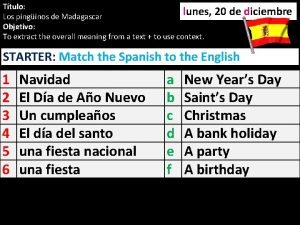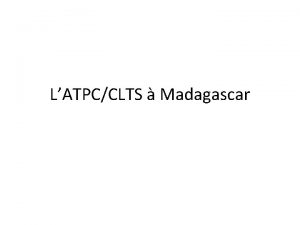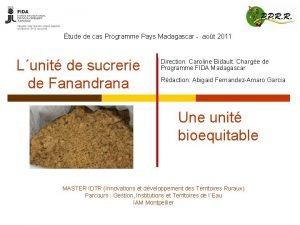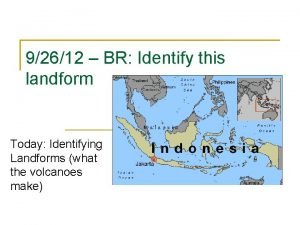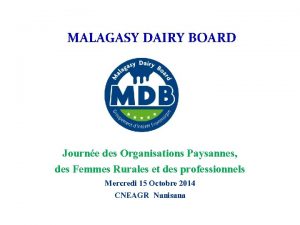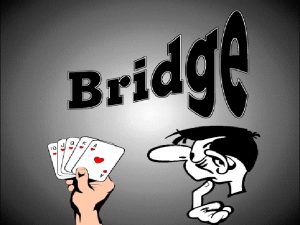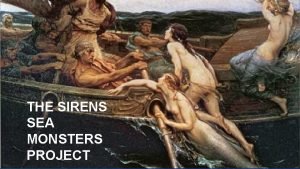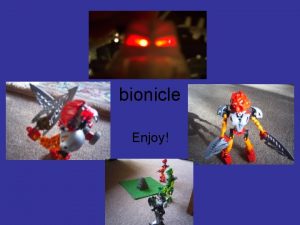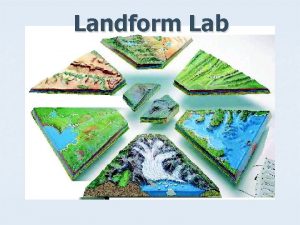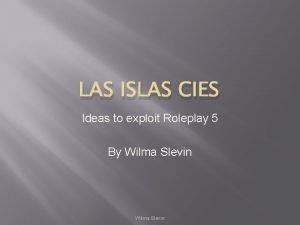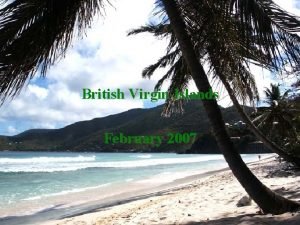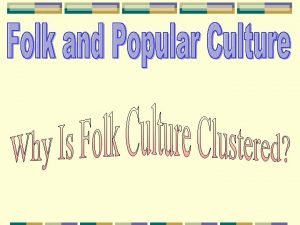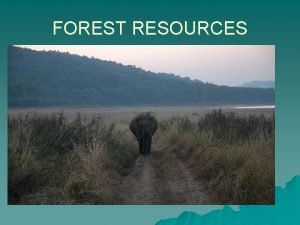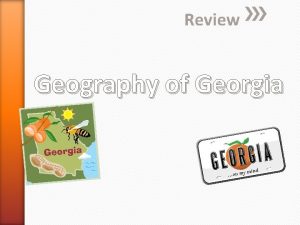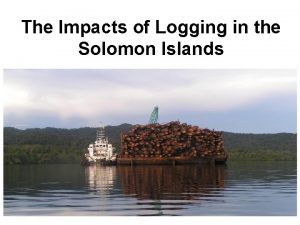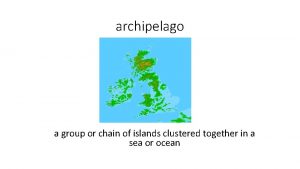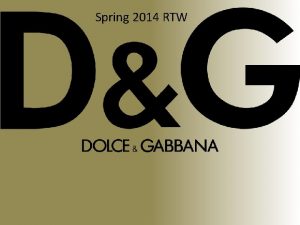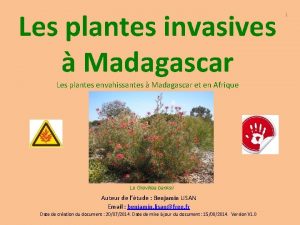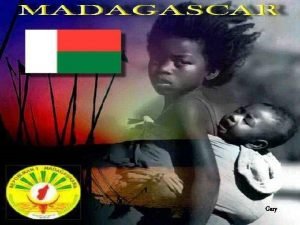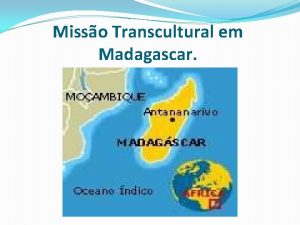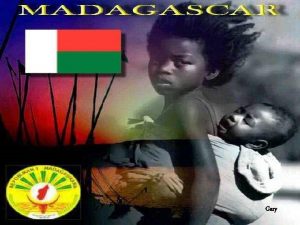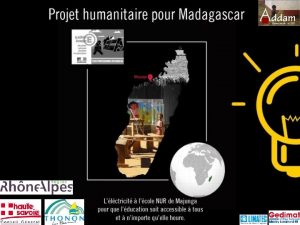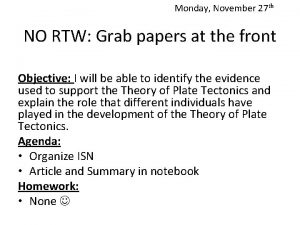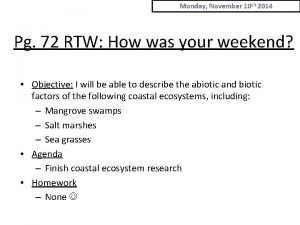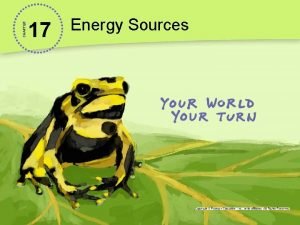RTW Monday January 22 nd Islands like Madagascar

































- Slides: 33

RTW Monday, January 22 nd • Islands like Madagascar & Australia have species that aren’t found anywhere else, what causes this phenomena?

RTW Monday, January 22 nd • Islands like Madagascar & Australia have species that aren’t found anywhere else, what causes this phenomena? GEOGRAPHIC ISOLATION

• Objective- I will be able to explain the scientific theory of evolution is supported through various disciplines • Agenda • Finish Vocab Sheet #2 - Natural Selection • Homework • None

RTW Tuesday, January 23 rd Until recently, scientist believed that the red panda was closely related to raccoons because they look and behave similarly. However, current evidence suggests their classification should be changed. Which would support the change in classification? A. The introduction of a new species in a different ecosystem B. The extinction of a raccoon species in a different ecosystem C. A microscope analysis of the cellular membranes of raccoons D. A DNA analysis of raccoons shows that they are very different animals

• Objective- I will be able to explain the scientific theory of evolution is supported through various disciplines • Agenda • Turn in Vocab Sheet #2 - Natural Selection • Taxonomy Notes • Homework • None

Taxonomy: Organisms can be classified based on physical similarities.

Taxonomy • = the science of naming and classifying organisms. White oak: Quercus alba • A taxon is a group of organisms in a classification system.

Binomial nomenclature • = two-part scientific naming system. – uses Latin words – scientific names always written in italics – two parts are the genus name and species descriptor

A genus includes one or more physically similar species – Species in the same genus are thought to be closely related. – Genus name is always capitalized. • A species descriptor is the second part of a scientific name. – always lowercase – always follows genus name; never written alone Tyto alba

Scientific names help scientists to communicate. – Some species have very similar common names. – Some species have many common names.

Linnaeus’ classification system • Each level is included in the level above it. • Levels get increasingly specific from kingdom to species

The Linnaean classification system has limitations. • Linnaeus taxonomy doesn’t account for molecular evidence. • The technology didn’t exist during Linneaus’ time. • Linnaean system based only on physical similarities.

• Physical similarities are not always the result of close relationships. • Genetic similarities more accurately show evolutionary relationships.

KEY CONCEPT Modern classification is based on evolutionary relationships.

Cladistics • = classification based on common ancestry • Phylogeny is the evolutionary history for a group of species. • evidence from living species, fossil record, and molecular data • shown with branching tree diagrams

• Cladistics is a common method to make evolutionary trees. – classification based on common ancestry – species placed in order that they descended from common ancestor

• A cladogram is an evolutionary tree made using cladistics. – A clade is a group of species that shares a common ancestor. – Each species in a clade shares some traits with the ancestor. – Each species in a clade has traits that have changed.

• Derived characters are traits shared in different degrees by clade members. – basis of arranging species in cladogram – more closely related species share more derived characters – represented on cladogram as hash marks 1 Tetrapoda clade 2 Amniota clade 3 Reptilia clade 4 Diapsida clade 5 Archosauria clade FEATHERS & TOOTHLESS BEAKS. SKULL OPENINGS IN FRONT OF THE EYE & IN THE JAW OPENING IN THE SIDE OF THE SKULL OPENINGS BEHIND THE EYE EMBRYO PROTECTED BY AMNIOTIC FLUID FOUR LIMBS WITH DIGITS DERIVED CHARACTER

• Nodes represent the most recent common ancestor of a clade. CLADE 1 Tetrapoda clade 2 Amniota clade 3 Reptilia clade • 4 Diapsida clade Clades can be identified by snipping a branch under a node. 5 Archosauria clade FEATHERS AND TOOTHLESS BEAKS. SKULL OPENINGS IN FRONT OF THE EYE AND IN THE JAW OPENING IN THE SIDE OF THE SKULL OPENINGS BEHIND THE EYE EMBRYO PROTECTED BY AMNIOTIC FLUID NODE FOUR LIMBS WITH DIGITS DERIVED CHARACTER

Molecular evidence reveals species’ relatedness. • Molecular data may confirm classification based on physical similarities. • Molecular data may lead scientists to propose a new classification. • DNA is usually given the last word by scientists.

RTW: Create a mnemonic device to help you remember the order of the Linnaean classification system (KPCOFGS) • Objective- I will be able to explain the scientific theory of evolution is supported through various disciplines • Agenda • Turn in Vocab Sheet #2 - Natural Selection • Taxonomy Notes • Homework • None

KEY CONCEPT The current tree of life has three domains.

Classification is always a work in progress. • The tree of life shows our most current understanding. • New discoveries can lead to changes in classification. • Until 1866: only two kingdoms, Animalia and Plantae Animalia – 1866: all single-celled organisms moved to kingdom Protista Plantae Protista – 1938: prokaryotes moved to kingdom Monera – 1959: fungi moved to own kingdom Archea Fungi Bacteria – 1977: kingdom Monera split into kingdoms Bacteria and Archaea

The three domains in the tree of life are Bacteria, Archaea, and Eukarya. • Domains are above the kingdom level. • proposed by Carl Woese based on r. RNA studies of prokaryotes • domain model more clearly shows prokaryotic diversity

• Bacteria and archaea can be difficult to classify. – transfer genes among themselves outside of reproduction bridge to transfer DNA – blurs the line between “species” – more research needed to understand prokaryotes

• Domain Bacteria includes prokaryotes in the kingdom Bacteria. – one of largest groups on Earth – classified by shape, need for oxygen, and diseases caused

• Domain Archaea includes prokaryotes in the kingdom Archaea. – cell walls chemically different from bacteria – differences discovered by studying RNA – known for living in extreme environments. Unicellular, prokaryotic organisms. Extremophiles: halophiles (love salt environments), thermophiles (love hot temperatures), Methanogens (loves methane gas/toxic environments).

• Domain Eukarya includes all eukaryotes. – kingdom Protista – Protists are eukaryotic organisms that cannot be classified as a plant, animal, or fungus. They are mostly unicellular, but some, like algae, are multicellular, like kelp. They can be autotrophic or heterotrophic.

• Domain Eukarya includes all eukaryotes. – kingdom Plantae – The Kingdom plantae includes all types of eukaryotic, multicellular, photosynthetic plants (autotrophic). Most of the organism in this kingdom is autotrophs, which synthesis their own food with the help of solar energy.

• Domain Eukarya includes all eukaryotes. – kingdom Fungi – is any member of the group of eukaryotic organisms that are heterotrophic (absorbing their nutrients from the ground) and includes unicellular microorganisms such as yeasts and molds, as well as multicellular fungi that produce familiar fruiting forms known as mushrooms. They can reproduce by sexual or asexual reproduction with the use of spores in most cases.

• Domain Eukarya includes all eukaryotes. – kingdom Animalia – Animals are multicellular, eukaryotic organisms of the kingdom Animalia. All animals are heterotrophic and motile, meaning they can move spontaneously and independently, at some point in their lives

RTW: Would 2 organisms be more closely related if they were in the same Class or Family? • Objective- I will be able to explain the classification of an organism based on distinguishing characteristics. • Agenda • Work on Kingdom Foldable • Homework • DIA #5 Friday 2/2

RTW: Which kingdoms have photosynthetic organisms? • Objective- I will be able to explain the classification of an organism based on distinguishing characteristics. • Agenda • Turn in Kingdom Foldable • Computer Lab • Homework • DIA #5 Friday 2/2
 Rational software analyzer
Rational software analyzer Anciana madagascar
Anciana madagascar Plan emergence madagascar 2019-2023 pdf
Plan emergence madagascar 2019-2023 pdf Diorano wash madagascar
Diorano wash madagascar Madagascar oil and gas
Madagascar oil and gas Eli madagascar
Eli madagascar Madagascar aot
Madagascar aot Macotex madagascar
Macotex madagascar Houston to madagascar
Houston to madagascar Stato insulare tra mozambico e madagascar
Stato insulare tra mozambico e madagascar Alondra the hedgehog
Alondra the hedgehog Gerald durrell madagascar
Gerald durrell madagascar Madagascar action plan
Madagascar action plan Brasserie star madagascar - historique
Brasserie star madagascar - historique Madagascar landforms
Madagascar landforms Grasshoppers in madagascar show variation
Grasshoppers in madagascar show variation Plan emergence madagascar 2019-2023 pdf
Plan emergence madagascar 2019-2023 pdf Mdb madagascar
Mdb madagascar Kani spil
Kani spil Sea of mediocrity
Sea of mediocrity Sirens facts
Sirens facts Bionicle nui kopen
Bionicle nui kopen Are valleys constructive or destructive
Are valleys constructive or destructive Cies islands permit
Cies islands permit Pitcairn islands
Pitcairn islands Study island skateboard game
Study island skateboard game Seattle to virgin islands
Seattle to virgin islands Trobriand islands
Trobriand islands Deforestation
Deforestation Gaps and islands
Gaps and islands Terraced farming definition world geography
Terraced farming definition world geography In what hemisphere does the prime meridian place georgia
In what hemisphere does the prime meridian place georgia Impacts of logging in solomon islands
Impacts of logging in solomon islands A group of islands clustered together
A group of islands clustered together

